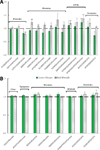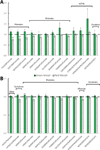Expression and distribution of neuropeptides in the nervous system of the crab Carcinus maenas and their roles in environmental stress
- PMID: 26475201
- PMCID: PMC4921240
- DOI: 10.1002/pmic.201500256
Expression and distribution of neuropeptides in the nervous system of the crab Carcinus maenas and their roles in environmental stress
Abstract
Environmental fluctuations, such as salinity, impose serious challenges to marine animal survival. Neuropeptides, signaling molecules involved in the regulation process, and the dynamic changes of their full complement in the stress response have yet to be investigated. Here, a MALDI-MS-based stable isotope labeling quantitation strategy was used to investigate the relationship between neuropeptide expression and adaptability of Carcinus maenas to various salinity levels, including high (60 parts per thousand [p.p.t.]) and low (0 p.p.t.) salinity, in both the crustacean pericardial organ (PO) and brain. Moreover, a high salinity stress time course study was conducted. MS imaging (MSI) of neuropeptide localization in C. maenas PO was also performed. As a result of salinity stress, multiple neuropeptide families exhibited changes in their relative abundances, including RFamides (e.g. APQGNFLRFamide), RYamides (e.g. SSFRVGGSRYamide), B-type allatostatins (AST-B; e.g. VPNDWAHFRGSWamide), and orcokinins (e.g. NFDEIDRSSFGFV). The MSI data revealed distribution differences in several neuropeptides (e.g. SGFYANRYamide) between color morphs, but salinity stress appeared to not have a major effect on the localization of the neuropeptides.
Keywords: Crustacean; Isotopic labeling; Mass spectrometry imaging; Neuropeptides; Salinity stress.
© 2015 WILEY-VCH Verlag GmbH & Co. KGaA, Weinheim.
Conflict of interest statement
The authors have declared no conflict of interest.
Figures




References
-
- Hiremagalur B, Kvetnansky R, Nankova B, Fleischer J, et al. Stress elicits trans-synaptic activation of adrenal neuropeptide Y gene expression. Brain Res Mol Brain Res. 1994;27:138–144. - PubMed
-
- Delorenzi A, Dimant B, Frenkel L, Nahmod VE, et al. High environmental salinity induces memory enhancement and increases levels of brain angiotensin-like peptides in the crab Chasmagnathus granulatus. J Exp Biol. 2000;203:3369–3379. - PubMed
-
- Chung JS, Zmora N. Functional studies of crustacean hyperglycemic hormones (CHHs) of the blue crab, Callinectes sapidus - the expression and release of CHH in eyestalk and pericardial organ in response to environmental stress. Febs Journal. 2008;275:693–704. - PubMed
Publication types
MeSH terms
Substances
Grants and funding
LinkOut - more resources
Full Text Sources
Other Literature Sources
Research Materials

